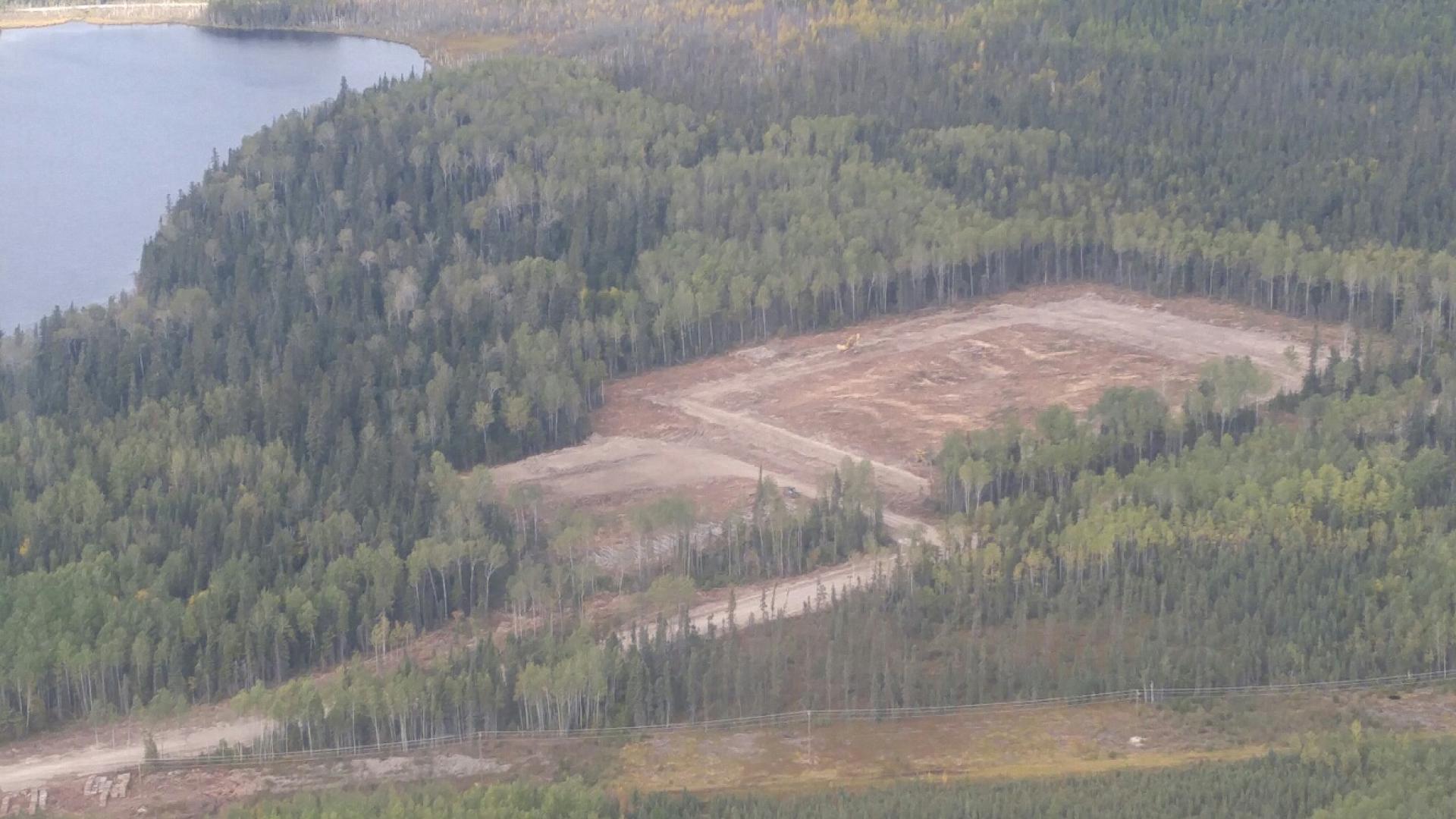Pikangikum First Nation is an Ojibway First Nation community located on the shores of Pikangikum Lake in the Kenora District of Northwestern Ontario. The community is remote: nestled in the heart of a vast boreal landscape, Pikangikum First Nation is only accessible by air year-round, by ice road for a few weeks in the winter, and by boat in the summer.
Supplied with electricity by oil and gas generators for several decades, the community was the first of 17 Northern Ontario communities to be connected to the electrical grid as part of the Wataynikaneyap transmission line project. Joining the electrical grid was a huge milestone for the remote community, making a significant difference to everyone who lives there. Although a welcome upgrade for the people of Pikangikum, being able to draw electricity from the Wataynikaneyap transmission line left a legacy of environmental issues directly associated with their long-term reliance on petroleum.
When the community was finally able to join the grid, it instantly rendered many in-community petroleum facilities obsolete and in need of decommissioning. Being reliant on petroleum fueled electricity for decades, the facilities unfortunately left the community with some 13 areas that were heavily contaminated by hydrocarbons. The community now had a large-scale remediation project to manage, and their remote location made it that much more of a challenging situation.
Projects in northern Ontario encounter many unique challenges: cold climates, remote locations, lack of infrastructure, rugged geography, challenging and variable ground conditions, and sparse populations. These challenges can result in transportation and material handling difficulties, labour productivity and scheduling complications, and require special design or equipment maintenance considerations. While all these challenges were ultimately faced by the community and team for the project, it was the remote project location that required a different approach to remediating the contaminated soil. Given its accessibility issues, the community sought innovative solutions to avoid the prohibitive cost of transporting this contaminated soil out of the region for treatment.
Working with Englobe and other project partners, the community assessed and built the sophisticated infrastructure needed to complete soil and water rehabilitation activities. In close partnership with the professional consulting and construction team, the community decided that building local infrastructure to treat the hydrocarbon-contaminated soil and water was the best long-term option. This would not only allow the community to take ownership of their environmental liabilities, but it would also expand its road network, and build the local capacity needed to treat future contaminants if needed.

Aerial view of the site of excavation and soil decontamination in the area formerly occupied by a diesel tank farm. Credit: Englobe.
Innovative environmental protection
Soil decontamination and rehabilitation, as well as the treatment of water, were central to this project, which is part of Pikangikum’s overall sustainable development perspective. This approach aligned perfectly with Englobe’s guiding principle of delivering sustainable solutions that add real value to the communities where they work.
“Our team worked to eliminate the contaminated soil problem in and around the community, but also to find a sustainable alternative to transporting contaminated soil outside its borders,” said Brandon MacKay, senior project manager of Site Remediation at Englobe. “Treating the soil onsite reduces transportation costs for the community and also measurably reduces greenhouse gas emissions generated by this transport.”
To break down the contaminated soils, the team selected a passive biotreatment technology. Initially collected and stockpiled, these soils are now in the process of being decontaminated. The team further designed and installed a state-of-the-art water treatment unit capable of adjusting treatment based on specific identified contaminants. This unit was used to treat the water from the soil excavation process.
The preservation of fauna and flora was a constant concern throughout the project. When preparing the project site to create the new road, the team worked with the community to establish a plan for tree cutting that would not only respect the local environment, but also support the community. For the project, tree cutting was reduced to an absolute minimum and all trees that had to be cut were sent to a sawmill that was mobilized on site. Members of the Pikangikum community operated the sawmill and cut all the trees into lumber that would stay in the community to be used for its residential construction or infrastructure development needs.

The remote location of the remediation project necessitated the use of a barge for transportation of heavy equipment. Credit: Englobe.
Health and safety solutions
Another important issue for the entire project was rigorous and highly proactive health and safety. Since the area to be rehabilitated was located in the community of Pikangikum, Englobe established health and safety protocols to ensure the protection of locals, especially the many children and elders. Actions included a traffic plan considering off-road vehicles, strategic positioning of resources to avoid accidents, installation of padlocked fences around excavated areas at the end of each day.
The COVID-19 pandemic was an added challenge. Due to the large number of immunosuppressed elders, the community was particularly vulnerable and extreme caution was exercised to ensure Englobe personnel were not spreading the virus. To protect community members and our workers, we implemented strict protocol for the entry of workers to the site, in addition to mobilizing additional housing units to allow for their isolation while awaiting a COVID-19 test result.
Benefits for the local community
One of the most important objectives for the project was to maximize the economic and social benefits for Pikangikum community members. As a start, the project team utilized various recruitment strategies to connect with locals and onboard them to support the work in various capacities. Through the duration of the project, over 20 community members were hired by Englobe to work as part of the project team. Bringing with them valuable knowledge of the area and community, this was a mutually beneficial partnership. Among other positions, a liaison officer was hired to ensure smooth communication, to maintain a good relationship with the community, and to help facilitate recruitment of community members.
Mentorship was also very important, and a thought-out plan was in place to mentor operators and day laborers on site rehabilitation activities such as the operation of the water treatment unit. This knowledge transfer was essential to building sustainable local capacity that would allow the community to manage future environmental issues. The local team played an integral part of the health and safety culture onsite and the project team ensured their participation in daily meetings and in the process of identifying hazardous situations. Adopting new health and safety habits is also something that will add lasting benefits to the community.
First Nation and local suppliers were prioritized for the execution of the work. Air and marine transportation activities related to the project were all provided by Aboriginal firms. We also leased equipment and infrastructure to the community to carry out the project. A great synergy of mutual aid developed with the community during the project, allowing the sharing of knowledge and technical resources (such as mechanical support, loan of operators, and tools).
“Our team developed a great synergy of mutual assistance with the community throughout the project,” explained MacKay. “We’re so proud of this project and of the relationships we built with the Pikangikum community. I believe we helped shift local perceptions about consultation and working with private partners and demonstrated that Indigenous-owned and managed projects can be very successful.”
Perhaps most importantly, the greatest benefit of the project was in that the serious health and safety risks that were presented by the legacy petroleum contamination were eliminated. Some of the contaminated areas in the community were in the heart of the town, they were in areas frequented by elders and were where kids played daily. By remediating the sites that posed the greatest direct threat to human life in the community, it had a direct impact on the health and wellbeing of the community.
Amanda Sauermann is senior communications advisor at Englobe.
Note: The Pikangikum First Nation remediation project was a finalist in the 2022 Brownie Awards “Remediate” category. Click here for further information.










